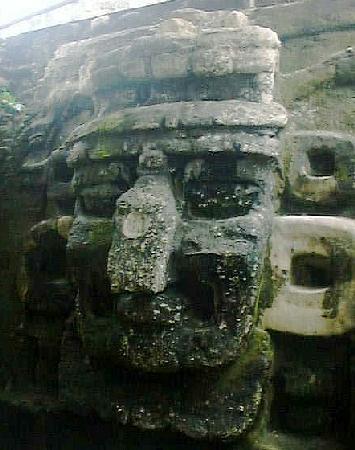
Tikal, Guatemala

The first view of the Grand Plaza as you enter Tikal
We came to Tikal from our base in Flores (actually Santa Elena), where we arrived from Chetumal in Mexico. At the border, we had to pay what was effectively a bribe to the border guard to get into the country, although everybody there tried to convince us that it was compulsory and official. Two of our party were smart enough to ask for a receipt, and so after a delay they got into Guatemala for nothing. We've learned our lesson, and will do the same in future, especially for countries where we've had to pay for visas, particularly if they're as expensive as Veronika's transit visa for Belize, which cost us 37 dollars. I think we may have been ripped of by the friendly but dodgy Belizean consul in Chetumal. Santa Elena is an ugly, muddy town whose only saving grace is the beautiful lake on which it sits. Flores, its twin town built on what was an island in the lake before a 500 metre causeway was built, is much prettier but also much more expensive - 30 dollars for a room compared to 7 in Santa Elena.
Tikal differs from many other Mayan ruins in that it is deep in the jungle, and most of the site, unlike Chichen Itza for example, has not been cleared. This means that it is also a good place to see some wildlife, including local animals - in our short stay at Tikal, we saw pizotes, toucans, Peten turkeys (which look more like pheasants/peacocks) and a whole range of other birds whose names I don't know. We also repeatedly heard - but alas failed to see - the howler monkeys; the noise they make is more of a roar than a howl, and reminded us at first of some sort of big cat - we thought maybe a jaguar.

A pizote at Tikal
Tikal was originally settled by the Maya around 700 BC, in part because the hill on which it is set provides some relief from the swampy, marshy low-lying ground around, and in part because the area is rich in flint, which was used to make clubs and sharp points for weapons and tools. By 500 BC, the Maya had started building stone ceremonial buildings. The Great Plaza started to be developed around the time of Christ, and by the start of the Early Classic Maya Period (ca. 250 AD), Tikal had grown in importance as a ceremonial, trading and cultural city and had a large population.
King Yax Moch Xoc, ruling about 230 AD, founded a dynasty which ruled Tikal until its abandonment. Yax Moch Xoc's successor, King Great Jaguar Paw, introduced a new method of war, surrounding the enemy and attacking them with spear-throwers. This method helped Smoking Frog, a Tikal general, to make Tikal the most powerful kingdom in the Peten region of Guatemala. Allied with Teotihuacan near Mexico City, Tikal grew in size until it had around 100,000 people and covered an area of 30 square kilometres. In 562, Lord Water came to power in Caracol (south-west Belize), and turned the Tikal warfare method against Tikal, defeating and capturing Tikal and becoming the pre-eminent power in the region until around 700 AD. At its height in 650-700 AD, Caracol had a population of around 150,000; the whole of Belize today has a population of less than 200,000.
Around 700 AD, King Moon Double Comb came to power in Tikal, and restored Tikal to its position as the greatest city in the Mayan world, which it remained until the general collapse of lowland Maya civilisation around 900 AD.
Tikal is a huge site, with long distances through the jungle between different groups and complexes. We managed to get lost once, and although we walked for a number of hours, we still didn't see all of the site. However, in contrast to Chichen Itza, we were able to climb almost all of the buildings. We even walked through a tunnel into one, on the north acropolis, where we found giant masks which had been hidden until uncovered by archaeologists - the Maya would build pyramids on top of old structures, apparently because it added to the religious-magical power of the structure. These masks are magnificent, I would guess eight or ten feet tall.

Giant mask at Tikal
One of the buildings at Tikal, Temple IV, is the tallest known pre-Columbian building in the western hemisphere at 64 metres. Climbing it is arduous, especially since the wooden steps which have been added to make the climb easier become very slippery when wet, but the view is simply fantastic, as at that height you are above the canopy of the jungle; all you can see apart from the jungle canopy are the tops of the very highest buildings of Tikal.

View from the pyramid at Tikal looking over the jungle canopy
Guatemala index | Travel index | Family history | Romany | Main index